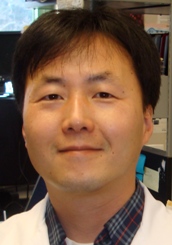
A new open access paper in Nature Neuroscience by Ju-Hyun Lee, PhD, Center for Dementia Research (CDR) Director Ralph Nixon, MD, PhD, and colleagues presents the latest evidence from the Nixon Lab challenging the prevailing theory of how Alzheimer’s disease originates. Rather, this research suggests that Alzheimer’s disease develops due to lysosomal dysfunction within cells, causing waste buildup which is a precursor to the extracellular amyloid plaques characteristic of Alzheimer’s. The paper by Lee et al. is featured on the June issue cover of Nature Neuroscience.
CDR Research Scientist Ju-Hyun Lee, who led the study, comments that “Our results for the first time sources neuronal damage observed in Alzheimer’s disease to problems inside brain cells’ lysosomes where amyloid beta first appears. Previously, the working hypothesis mostly attributed the damage observed in Alzheimer’s disease to what came after amyloid buildup outside of brain cells, not before and from within neurons.”
According to senior investigator Dr. Nixon, “This new evidence changes our fundamental understanding of how Alzheimer’s disease progresses; it also explains why so many experimental therapies designed to remove amyloid plaques have failed to stop disease progression because the brain cells are already crippled before the plaques fully form outside the cell. Our research suggests that future treatments should focus on reversing the lysosomal dysfunction and rebalancing acid levels inside the brain’s neurons.”
Alzforum, a networking site for Alzheimer’s research, highlights the article by Lee et al. in a piece titled “Behold PANTHOS, a Toxic Wreath of Perinuclear Aβ That Kills Neurons” which has received numerous comments.
CDR coauthors of this paper are Dun-Sheng Yang, Chris Goulbourne, Eunju Im, Philip Stavrides, Anna Pensalfini, Cynthia Bleiwas, Martin Berg, Chunfeng Huo, James Peddy, Monika Pawlik, Efrat Levy, and Mala Rao. To read more about these findings, see the NYU press release.
Reference: Lee JH, Yang DS, Goulbourne CN, Im E, Stavrides P, Pensalfini A, Chan H, Bouchet-Marquis C, Bleiwas C, Berg MJ, Huo C, Peddy J, Pawlik M, Levy E, Rao M, Staufenbiel M, Nixon RA. Faulty autolysosome acidification in Alzheimer’s disease mouse models induces autophagic build-up of Aβ in neurons, yielding senile plaques. Nat Neurosci. 2022 Jun 2. doi: 10.1038/s41593-022-01084-8.

